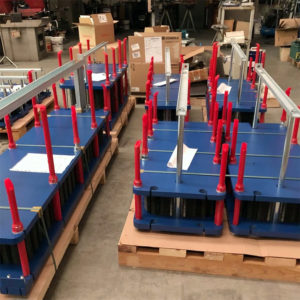

Each plate in a plate heat exchanger has slots aimed to insert sealing gaskets, feedbacks for the right plates coupling during the mounting phase, two pair of holes for inlet and outlet of the fluids and corrugations in several different designs.
Corrugations have an important function, providing:
This solution offers a weight and size reduction by the 25-30% compared to tube exchangers, in addition to a thermal transfer efficiency increased even up to three times. In a plate heat exchanger all of the surfaces are involved in the thermal transfer process, without any structure, tie beams or diaphragms that are instead present in a shell and tube exchanger and not contributing in any form to the thermal transfer. As a direct consequence, plate heat exchangers also require a transfer surface reduced by 1/3 or even 1/5. Plate heat exchangers are therefore a compact, modular, flexible and efficient solution. And more advantages will be clear going through what follows.
Immersion dimple jacket exchangers are instead a smart alternative solution to coil exchangers, thanks to the substitution of meters of pipes plunged in a tank with customized plate packs, dimpled and inflated to obtain internal channels allowing the flowing of the heating/cooling fluid. The high turbulence of the fluid generated in this kind of solution ensures higher thermal transfer efficiency, in addition to customizable sizes and connections, limited costs and easy installation.
In coil heat exchangers the two fluids flow over the opposite surfaces of a smooth metal sheet in chambers rolled up in the shape of a spiral. This kind of exchanger offers easy cleaning operations and is thus employed for very viscous and dirty fluids, often in applications such as water purification and waste water treatment.
Block heat exchangers are characterized by cylindrical or oval bores in which the fluids flow, usually with an orthogonal design in both sides (typical construction of graphite block exchangers).
Finned pack heat exchangers, or radiators, are finally employed in the thermal transfer between air and a liquid fluid, typically water or oil. The liquid flows inside tubes while the gaseous fluid flows within the finned pack outside the tubes, often pushed by fans employed to increase and provide the right flow rate.
